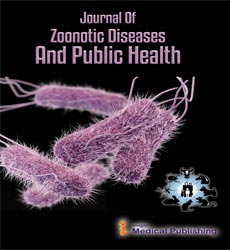Modern Humans Evolved from Homo sapiens
Monica Das*
Department of Public Health, University of Otago, Wellington, New Zealand
- *Corresponding Author:
- Monica Das
Department of Public Health,
University of Otago, Wellington,
New Zealand,
E-mail: dasmoni7@gmail.com
Received Date: September 24, 2021; Accepted Date: October 08, 2021; Published Date: October 15, 2021
Citation: Das M (2021) Modern Humans Evolved from Homo sapiens. J Zoonotic Dis Public Health Vol.5 No.S1:e002.
Editorial Note
The evolution of public health may be a continuing process; pathogens change, as do the environment and therefore the host. In order to face the challenges ahead, it's important to possess an understanding of the past. Although there's much during this age that's new, many of the present debates and arguments publicly health are echoes of the past. Experience from the past may be a vital tool within the formulation of health policy. An understanding of the evolution and context of those challenges and innovative ideas can help us to navigate the overall public health world of today and thus the longer term.
The Paleolithic Age is that the earliest stage of human development where organized societal structures are known to possess existed. These social structures are known to have existed. These social structures consisted of people living in hands which survived by hunting and gathering food. There is evidence of the utilization of fireside going back some 230,000 years, and increasing sophistication of stone tools, jewellery, cave paintings, and non-secular symbols during this era. Modern humans evolved from Homo sapiens, probably originating in Africa and therefore the Middle East about 90,000 years ago, and appearing in Europe during the ice age period. During this point, humanity covers all major land masses following the retreating glaciers of the last glacial period at 11,000-8000 BCE.
A Mesolithic Age or transitional phase of evolution from hunter-gatherer societies in to the Neolithic Age of food raising societies occurred during different periods in various parts of the world, first within the Middle East from 9000 to 8000 BCE onward, reaching Europe about 3000 BCE. The change from hunting, fishing, and gathering modes of survival to agriculture was first evidenced by domestication of animals then the growing of grain and root crops, and vegetables. Associated skills, including food storage and cooking, pottery, basket weaving, ovens, smelting, and trade, led to improved survival techniques and increase gradually spread throughout the planet.
Communal habitation became essential to adaptation to changing environmental conditions and hazards, allowing increase and geographic expansion. At each stage of human biological, technological, and living patterns, seeking herbal and mystical treatments for the maladies. People called on the supernatural and magic to appease these forces and stop plagues, famines, and disasters. Shamans or witch doctors attempted to get rid of harm by magical or religious practices alongside herbal treatments acquired through trial and error. Life expectancy in prehistoric times was 25-30 years, with men living longer than women, probably because of malnutrition and maternity- related causes.
As human society evolved, technologically, culturally, and biologically, nutrition and exposure to communicable and non- disease changed. Social organization led to innovations in tools and skills for hunting, clothing, shelter, fire for warmth and cooking, food to be used and storage, burial of the dead, and removal of waste products from living areas. Adaptation of human society to the environment has been and remains a central issue in population health. This is a recurrent theme within the event of public health, with resilience in facing daunting new challenges of adaption and balance with the environment.
Open Access Journals
- Aquaculture & Veterinary Science
- Chemistry & Chemical Sciences
- Clinical Sciences
- Engineering
- General Science
- Genetics & Molecular Biology
- Health Care & Nursing
- Immunology & Microbiology
- Materials Science
- Mathematics & Physics
- Medical Sciences
- Neurology & Psychiatry
- Oncology & Cancer Science
- Pharmaceutical Sciences
